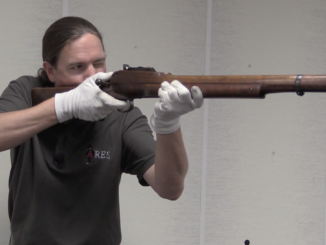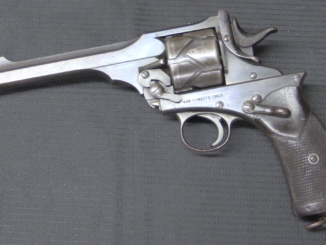Sorry for the poor audio quality – I am back at the Cody Firearms Museum talking to Jonathan Ferguson, Keeper of Firearms & Artillery at the Royal Armouries in the UK. Jonathan has written a new book on the history of British bullpup firearms, which Headstamp is very proud to be publishing!
Today we are talking about the British E.M.2 bullpup rifle in the 1950s NATO trials, which were intended to find a single rifle and cartridge to unify all NATO nations. After the experience of logistical supply in World War Two, everyone realized that in a future conflict it would be a great advantage to all use the same basic equipment. However, the various nations came into the trials with different ideas of what was ideal in a rifle and cartridge – in particular the United States and the United Kingdom.




America: We’ve already got a cartridge for the job (.308 Winchester, one variant of which became 7.62×51 NATO) and we can EXPORT tooling for the cartridge we already have in mass production! Why reinvent the wheel?
UK of the 1950’s: You blokes have no idea what you’re getting yourselves into! Your idea of a universal cartridge will break everybody’s shoulders and everyone will complain that they will have to rely on your charity!
America: Your fancy under-powered rifle combined with your crazy reloading procedure takes a full minute to change magazines, by which point your soldiers have already been shot dead from a mile away!
How’s that for a stupid argument?
I’m glad Ian finally said it (.280=low end of full-power rifle cartridges). It is a close parallel of the 7.62 NATO itself: a shortened ballistic twin of numerous turn of the century bolt rifle cartridges.
Leveraging advances in case geometry and powder to duplicate that performance in a compact cartridge was interesting technologically, but (all melodrama about blind, evil Americans vs. game-changing innovators aside) .280 is still too powerful for autorifles to replace SMGs or LMGs, and it still has the Mauser case diameter (dictating either low capacity or huge mags, PLUS insignificant weight difference vs. .308).
“(…).280(…)PLUS insignificant weight difference vs. .308).(…)”
Ok, but I think it was noting that Great Britain would replace ·303 British using .280, whilst United States replaced 7,62×63 mm using 7,62×51 NATO. In former case difference is greater as it is going from rimmed to rimless, thus making designing box magazine, especially of greater capacity, easier.
“(…).280 is still too powerful for autorifles to replace SMGs (…)”
Although, judging from British decision, they did not want to drop SMG completely, as they decided to adopt Sterling: https://modernfirearms.net/en/submachine-guns/great-britain-submachine-guns/sterling-l2-l34-eng/
in 1953 and started production.
Both excellent and valid points, but I don’t believe they contradict mine:
“Great Britain would replace .303 British using .280 . . . rimless . . . making designing box magazine, especially of greater capacity, easier.” When they ended up adopting 7.62 NATO, it was also rimless – and of identical (.473″) rim diameter to .280, making box magazine capacity identical as well.
“. . .[J]udging from British decision, they did not want to drop SMG completely . . .” My point was that, had they adopted a true intermediate cartridge (not 7.62 and not .280) the adoption of the Sterling would have been unnecessary – as it is today, when they use 5.56. It’s likely that Sterling development paralleled that of the .280, further reinforcing the point that the Brits didn’t consider .280 intermediate either.
Going from rimmed 303 to rimless 280 result in obvious gain.
Going from rimless 7,62×63 to rimless 7,62×51 result in lesser gain, is it worth all investment required? In other words: are these cartridge different enough, so first must have been replaced?
Ah – excellent question! As you implied, the answer would certainly have been “no” if it was only about the cartridges (i.e. if the services kept WWII weapons).
Since the US had decided to build detachable-magazine rifles (Garand-based, but with different gas systems) AND acquire GPMGs (unrelated to any serving US system), they accepted the minor additional effort to engineer them for a 1/2″ shorter cartridge (that shortened / lightened numerous components). That’s reasonable. The fact that they spec’d a cartridge with identical performance and then pretended it would confer the benefits of an intermediate cartridge, on the other hand . . .
LTC (later COL) Rene Studler had a 13 year (!) term as Chief of Small Arms Division of Ordnance, He was never Che Chief of Ordnance (a general officer position).
“René R. Studler, born 10 February 1895 in Bluffton, Ohio, graduated from Ohio State University in 1917. He joined the Army and earned his pilot’s wings, and from 1918 to 1919 served as Flying Instructor at the Air Service Flying School in Texas and then Oklahoma. From 1919 to 1921 he was Operations Officer and then Commander of the 258th Heavy Bombardment Squadron, later redesignated Flight B, 14th Squadron (Bombardment), stationed at Aberdeen Proving Ground (APG), Maryland. Studler’s squadron was heavily involved in the testing of aircraft ordnance.
Intrigued with the work of developing weapons, Studler transferred from the Air Service to the Ordnance Department in 1922. After completing the two-year Ordnance School of Application at Watertown Arsenal, which included studies at the Massachusetts Institute of Technology, he reported to the Office of the Chief of Ordnance (OCO) in Washington, DC, to serve as Assistant Small Arms Officer in the Small Arms Division. He worked as a troubleshooter, making repeated trips to APG, Frankford Arsenal in Philadelphia, Springfield Armory in Massachusetts, and civilian industries to consult on development and production issues or to advise on maintenance procedures.
Studler next served, from 1928 to 1929, as Proof Officer in the Gun Testing Division at APG, where he continued his work in developing and testing small arms. From 1929 to 1931 he was stationed in the Philippines as Commander of the 75th Ordnance Company and then as Adjutant, Executive Officer, and finally Commander of the Philippine Ordnance Depot. Returning to the United States, he served as Assistant Officer in Charge, then Officer in Charge, of the Engineering Division of the Small Arms Ammunition Department at Frankford Arsenal. He was commended for his development of armor- piercing .30 and .50 caliber ammunition.
In 1935, Studler returned to OCO to serve again as Assistant Small Arms Officer in the Small Arms Division. While there he applied for a three-month leave of absence to visit European small arms and small-arms ammunition manufacturing facilities. His resulting report so impressed his superiors that Studler was assigned in 1936 as Assistant Military Attaché at the US Embassy in London to continue his reporting. Proficient in five European languages, Studler had carte blanche to roam throughout Europe gathering technical intelligence. Visiting factories and military facilities, he filed 373 reports on everything from small arms to tanks to aircraft.
As important as Studler’s work in technical intelligence was his expertise in small arms was even more in demand, and in 1940 he was recalled from Europe to again serve in the Small Arms Division in the Office of the Chief of Ordnance, this time as Chief. He held this position for the next 13 years, playing a vital role in developing ground and aircraft-mounted weapons and accessories, to include the M-1 helmet, .30 and .50 caliber armor-piercing incendiary ammunition, the M3 aircraft machine gun, the M3 submachine gun, the M1 and M2 carbines, the 2.36 inch and 3.5 inch rocket launchers, and the 57mm, 75mm, and 105mm recoilless rifles. Studler retired in 1953 after 36 years of distinguished service. He died in August 1980.”
My opinion areplaced the LMG)bout the EM2 and 280 cartridge, 1) As it was never adopted, it has acquired a mythic status that it may 2) the cartridge was caught between two points – too heavy for a LMG and too light for a MMG or GPMG (which really replaced the MMG and never the LMG, which is why I question the entire Einheitsgeweher concept)
1) The EM-2 was adopted by the British Labor Attlee government as the No. 9 Automatic Rifle, Mk.I. 2) the conservative Tory government of Winston Churchill dropped it, and moved to adopt the 7.62x51mm cartridge, and the UK army understood that it was ill-suited for full auto, hence the L1A1 or SLR being a self-loading rifle. The Cold War-era British squad thus had gone from bolt action rifles firing rimmed cartridges, an excellent LMG, and an NCO or officer toting a dangerous 9mm SMG of WWII to the U.S. WWII squad of self-loading rifles, and an NCO or officer toting an SMG, albeit with either a much-improved Bren gun or the FN-MAG GPMG.
Winston Churchill understood that the UK needed the U.S. and Canada in WWI, and even more so in WWII. The idea that the dropping of the .303 would lead to a cartridge not manufactured in the USA was anathema to the actual experience of waging a World War. Perhaps the Attlee government knew that if war resumed in Europe, it would go thermonuclear, and there’d be no need for U.S. imports? The de-facto Nato cartridge when the alliance was formed was the U.S. .30-06 or 7.62x63mm. If the U.S. called the shots for Nato, then why not the U.S. preference for the 7.62x51mm? But why bother with the 7.62x51mm instead of adopting Paul Mauser’s first smokeless cartridge, the 7.65x53mm that had been manufactured since what? 1889?
The Germans during the late Third Reich fantasized about replacing 9mm SMGs and bolt-action 8x57mm rifles with the 8mm kurzpatrone StG44 and later the StG45. The crummy intermediate eye relief scope the Zf-41 was sometimes bandied about as a close to general issue sighting aid for particularly adept marksmen in the German infantry squad. It would seem that the British looked to replacing a) rimmed cartridges, b) SMGs, and c) bolt-action rifles in one fell swoop, jumping ahead technologically in much the same fashion as the poor benighted French sought to cling to the 8x50Rmm Lebel until something like, say, the 7.5x54mm self-loading rifle was good and ready!
My understanding is that the British hewed to a PDW concept such that even if the No.9 Automatic Rifle/ EM-2 had been adopted, the rear echelon would have had Madsen M-50 9mm SMGs… When Churchill killed off the EM-2 and urged adoption of the L1A1 FAL, it is worth noting that the EM-2 might have been retained… as a light automatic rifle or replacement for the 9mm SMG! But, instead, the Sterling SMG was adopted in its stead. I can’t wait to get the latest Headstamp Publishing book and learn a great deal, and have some of my current (mis)understandings disabused.
The LMG version of the EM-2 was the belt-fed TADEN, although it may have been for the company rather than the section or squad level?
I think “PDW” is a term not older than 30 years, retconning much
I agree. I think it was just some sort of compact weapon intended for rear echelon troops. Not a “PDW” by name, but basically in concept, a bit like the U.S. carbine, cal. 30 M1.
Seems like a question not only of standardization, but one of consolidation.
Fully agreed that it was good for allies to standardize on small arms ammo, and the cartridge that the Brits had deserved a fair look that it did not get. But what was the deal with consolidating cartridges at the expense of dropping entire classes of small arms?
In WWII the US Army and Marines had 3 cartridges (.45ACP, .30-06, and .30 Carbine) to keep up with, and even more than if one counts .50 BMG and the odd .38 revolver and .380 automatic ammunition. But logistics seemed to have been the US’s biggest strength in the war. Then after WWII there was a strong drive to consolidate cartridges, even to the point of pretending that a full-size battle rifle could replace the SMG and the carbine. (Realize that the British rifle could sort of be a carbine and maybe an SMG in a theoretical sort of sense, but anyone who thought an M14 could function as a carbine or as an SMG was a lunatic.)
Question is if the drive to consolidate cartridges was born of battles lost in WWII when platoons needed 30-06 but only had 30 carbine, or could not use their SMG’s because they only had 30 carbine, etc., or if it was more of a theoretical consideration? Were any battles actually lost on the allied side in WWII due to having one cartridge for rifles, one for carbines, and one for SMG’s?
What was driving the consolidation such that one would be driven to make-pretend that a rifle of the era could replace an SMG? Or think that carbine ammo would be so excruciatingly hard to supply that they should just pretend that a really popular weapon like the M1 Carbine never existed, and replace it with a rifle that was even longer than the M1 Garand?
The point is, the number of allied cartridges in WWII was a mess, but it was a mess that worked. Then after the war the race was on to replace every last small arm with one arm firing one cartridge. Seems the pendulum swung too far the other way.
Well noted, Jacob. America messed up by trying to make a “do-everything” gun. The Germans and the Russians stumbled upon what seems to be the realistic system for long-arms: Regular grunts get the intermediate rounds and the weapons to match (jack of all trades, master of NONE), while specialists get the full-power stuff or otherwise. There is no “do everything” gun. I could be wrong.
The M1 carbine was apparently intended to replace the .45 acp, but instead supplemented it. The M1 carbine might have rendered the SMG superfluous, but instead augmented it what with the M1 Thompson, the M1A1, and the M3 and M3A1. By the time the U.S. faced operations to invade Kyushu and then Honshu on the Japanese mainland, there was an M3 carbine with an infrared sight, and discussions underway to make the Garand a 20-shot BAR-magazine fed rifle, perhaps a bit like the Italian BM-59.
Meanwhile, everyone in Europe was relieved the war was over, and people picked through the national experience in search of what should follow… France decided that it really did need a 9-mm SMG, but that it could resume where things left off in 1940 and picked-up again in 1944-45 with the 7.5x54mm cartridge and the bolt-action and self-loading rifles to fire it… Meanwhile, the Soviets had the 7.62x41mm in the works, and eventually, the 7.62x39mm that would be the “planned obsolescence” of the SKS and RPD, followed by the Kalashnikov and eventually, the RPK. Belgium and a few other nations looked into the German 8mm kurz cartridge, liked what they saw, but then tinkered with alternatives driven by the has-been European power, the UK, and the uncontested super-power, the U.S. In the U.S. people convinced themselves that because they’d won (ignoring things like, say, the Soviet contribution to destroying the Wehrmacht) and reasoned that the laurels garnered could be slept upon… All that was needed was to finally go from a suite of weapons in .45, .30 carbine, .30-06, and box-magazine .30-06 vs. en-bloc .30-06 and belt-fed .30-06 and develop one that would “rule them all” and that the rest of Nato, now using all of the above plus 9-mm. could be using as a new standard.
The U.S. won the war, and thought the German StG44 was a cheap-to-produce “improved SMG.” The MG42 GPMG was a neat idea, and they’d look into it. The UK had fought WWI without a rimless cartridge, and then WWII with the same cartridge, and belatedly decided that if replace the .303 they must, why not something “radical” and new-fangled–something which the nation that used smooth-bore muskets well into the 1840s had never really had… Enter the EM-1 and EM-2.
No other nation within Nato really had the clout to introduce an alternative cartridge or weapon system utterly different from the Anglo-American dispute and French insistence to “go their own way.” So the U.S. insisted on a 7.62x51mm as an absolute minimum, shortly to be abandoned for new hyper-velocity small-caliber cartridges developed by private industry, while Britain tried to get the U.S. to see that if full-auto was envisioned, then a smaller cartridge was certainly necessary, and Belgium stood by to make the rifle to suit the winning cartridge. In the end, the SMG didn’t go away except in U.S. service–apart from long range patrols and by armored crews–and in Soviet service–superseded by the Kalashnikov. But every other Nato nation pretty much continued to issue SMGs alongside the full power rifles until the early 1980s when the second Nato standard, the Belgian SS109 version of the U.S. 5.56mm cartridge came on the scene….
There’s a PhD thesis somewhere, that looks into the surviving paperwork behind the .280
The initial studies were pointing towards something between .250 and .270
The initially proposed case was on the slightly smaller Carcano headsize. I don’t know whether any of those were even made.
Apparently both calibre and case capacity began to grow once “American” (Studler’s) desires for 600m – 800m performance became known, and the calibre designation was also exaggerated to .280, which it was hoped, wouldn’t remind Americans of the .276 Pedersen.
In that sense, the concept changed from something with a little bit of study and evidence behind it, into something that would meet the arbitrary whims of one individual who happened to hold a position in a bureaucratic hierarchy.